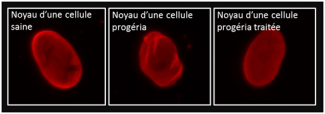A recent study, conducted by Dr Xavier Nissan (I-Stem, INSERM U861) in collaboration with Pr Nicolas Lévy (Aix Marseille University, INSERM UMR_S910, Faculty of Medicine of Marseille) shows that the anti-diabetic drug metformin is able to rejuvenate cells from patient suffering of a rare accelerated aging disease. This work supported by AFM-Telethon, was published in November 10, 2016 in Aging and Mechanisms of disease (Nature partner journal). Together, results of this French team suggest a new therapeutic avenue for the treatment of this syndrome and support the use of metformin as a potential anti-aging drug.
Progeria, or Hutchinson-Gilford syndrome, is a rare genetic disease causing an accelerated aging. This syndrome is due to a mutation of the LMNA gene that leads to the production of a toxic protein called progerin. “Drugs that are currently evaluated on progeria patients aim to induce progerin degradation or decrease its toxicity but none of them acts on its production. That’s what we sought to identify in this study” says Dr. Xavier Nissan.
To succeed, the I-Stem’s team searched for a molecule capable of shifting the balance between different proteins produced from the LMNA gene. “We knew that this gene could encode for progerin but also for others A type lamins. Our idea was to find a drug that can alter this balance in order to force cells to produce only the normal lamins”. To do so, authors used bone and vascular cells derived from induced pluripotent stem cells (iPS cells) as a pharmacological model of progeria syndrome.
The starting point of their work was the publication of another study showing global gene expression modifications upon metformin treatment. “This drug regulates the expression of hundreds of genes including the one that was described to control the balance of normal A type lamins” explains the researcher. They confirmed their hypothesis by observing that progerin expression was significantly reduced in progeria patients’ cells treated with the drug. “Interestingly several groups have already report the use of metformin as an anti-aging drug. Because progerin is also expressed in normal aging, our results suggest also a new way to explain, at least partly, the positive impact of this drug on aging “.
The researchers observed also that metformin treatment resulted in an improvement of the main sign of normal and accelerated aging “in vitro, one of a major consequence of progerin expression is the disorganization of nuclear shape. Our work describes that metformin treatment normalizes this mark of aging. “
 Figure legend: Improvement of nuclear shape abnormalities in progeria cells treated with metformin. Nuclei are revealed with lamin A/C staining (in red)
Figure legend: Improvement of nuclear shape abnormalities in progeria cells treated with metformin. Nuclei are revealed with lamin A/C staining (in red)
“These results suggest a new therapeutic approach, alone or in combination with other molecules, for the treatment of progeria. Metformin’s benefit has now to be evaluated in relevant animal models of this syndrome,” said Dr. Nicolas Levy, co-author of the study. They demonstrate once more the interest of pluripotent stem cells for the discovery of new treatments.

